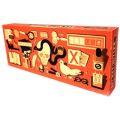
Now they have to wait for their turn in Marching Order and spend their action to pull the switch. It’s no longer a case of a player saying ‘I pull the switch’. The Interact action there also allows us to have a proper weight to things like pulling switches, disrupting trap components, and so on. It also allows us to design traps and hazards with more specific responses, such as ‘as an action, a player may choose to do x’ (such as go prone to avoid a swinging blade trap). We now have clearly defined actions that a player can perform on a given turn. Interact – Interact with a mechanism, trap component or other object within your reach. Sneak – Make a Stealth check to move undetected. Scout Ahead – Make a Perception check at a -5 penalty to attempt to perceive traps, hazards or enemies in an adjoining room or corridor to the one you are currently in. For all intents and purposes, a ‘marching order round’ takes the same length of time as a combat round (6 seconds).ĭetect Hazards – Make a Perception check to attempt to perceive a trap or hazard within your character’s field of view.ĭisarm a Trap – Make a skill check to disarm an adjacent trap that you have perceived.Īttack – Perform a single attack targeting a creature or object. I’m going to base this mostly on the sorts of things the PHB and DMG clearly expect you to be doing in dungeons. Now we have laid out the sort of speed we expect players to proceed down corridors at. Let’s say there are 3 different moves you can make: cautious move, standard move, hasty move.Ī Cautious Move lets you proceed 10 ft forward, maintains your passive perception, and lets you perform 1 action.Ī Normal Move lets you proceed 20 ft forward, incurs a -5 penalty to passive perception and lets you perform 1 action.Ī Hasty Move lets you proceed 30 ft forward (or up to your maximum speed, whichever is smaller), incurs a -10 penalty to passive perception and lets you perform 2 actions. Also, as Combat Mode ends we may go either into our normal adventuring state of play or directly into Dungeon Crawl Mode with the DM again calling for the players to set a Marching Order.Įach turn, the next player in the Marching Order takes their turn, performing a limited set of actions.įirst of all let’s set some movement options. Dungeon Crawl Mode will end either when Initiative is rolled or the DM stops calling for actions in your Marching Order.

So our Dungeon Crawl Mode begins with the DM calling for the players to select a Marching Order for the next corridor. Let’s set the most fundamental piece of our Dungeon Crawl Rules: In what order does play proceed? Combat uses Initiative, and personally I think the most intuitive format for the Dungeon Crawl is Marching Order. For reference, combat Mode for the most part starts when initiative is rolled and ends when the DM drops the players out of initiative order.

First of all, let’s tacitly accept that we’re going to need a ‘Dungeon Crawl Mode’ much as we have a ‘Combat Mode’.
Scrawl rules how to#
It seems as time has gone by D&D has kept the rules for traps, obstacles, hazards, dungeon structures and all things related to dungeon crawls but have slowly phased out the actual nitty-gritty rules of how to traverse the dungeon itself.Īs much as I’m a little peeved that I should have to do this in the first place, it’s not too difficult to come up with some robust yet simple rules to help keep our dungeon crawls orderly. But the rules for the actual dungeon crawl are completely nonexistent. There’s even entire class features that directly interact with common dungeon mechanics. The weird thing about this is there’s still rules pointing toward this nonexistent dungeon crawl system. It’s this bizarre glaring hole in D&D 5th Edition, and indeed a few editions prior, that once noticed cannot be unnoticed. So how does a dungeon crawl work? Do you have turns? Are there actions you can take? Do traps roll initiative? There’s more detail to each of those things, but it’s very clearly laid out what a combat is and how one works. On your turn you have movement, an action and potentially a bonus action. Everyone rolls initiative and takes turns in order based on their initiative roll. Here’s another question, and one you can answer fully: Mechanically speaking, how do you run a combat? How do you run a dungeon crawl? No not just ‘have the party clear traps and fight monsters’ I mean specifically how do you have them do that? Where The F*** Are The Dungeon Crawl Rules?īack in the day the D&D core books included very clear rules for how to proceed through a dungeon, as well as the rules for what might be in a dungeon and how to interact with it (think traps, puzzles, monsters, etc).


It’s a part-rant, part-ruleset about dungeon crawling, because a few months ago I noticed something was horribly wrong with 5th Edition Dungeons & Dragons. This is going to be a bit of a strange one.


 0 kommentar(er)
0 kommentar(er)
